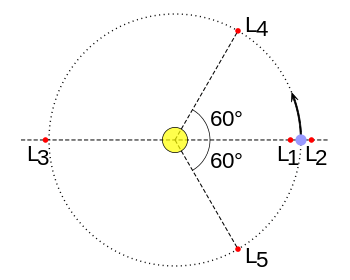Trojan (astronomy)
In astronomy, a trojan is a minor planet or natural satellite (moon) that shares an orbit with a planet or larger moon, but does not collide with it because it orbits around one of the two Lagrangian points of stability (trojan points), L4 and L5, which lie approximately 60° ahead of and behind the larger body, respectively. Trojan objects are also sometimes called Lagrangian objects. They are one type of co-orbital object. In this arrangement, the massive star and the smaller planet orbit about their common barycenter. A much smaller mass located at one of the Lagrangian points is subject to a combined gravitational force that acts through this barycenter. Hence the object can orbit around the barycenter with the same orbital period as the planet, and the arrangement can remain stable over time.[1]
Trojan minor planets are minor planets that orbit near one of the two trojan points of a planet. A trojan moon is a moon residing at the trojan point of another (larger) moon. Trojan planets are theoretical planets that orbit at the trojan points of other planets.
Saturn has the only known trojan satellites: Saturn's moon Tethys has two trojan moons (Telesto and Calypso), and Dione also has two trojan moons (Helene and Polydeuces).
In 2011, NASA announced the discovery of the first known Earth trojan.[2]
Numerical calculations of the orbital dynamics involved indicate that Saturn and Uranus probably do not have any primordial trojan minor planets.[3]
Trojan minor planets

In 1772, the Italian–French mathematician and astronomer Joseph-Louis Lagrange obtained two constant-pattern solutions (collinear and equilateral) of the general three-body problem.[4] In the restricted three-body problem, with one mass negligible (which Lagrange did not consider), the five possible positions of that mass are now termed Lagrangian points.
The term "trojan" originally referred to the "trojan asteroids" (Jupiter trojans) that orbit close to the Lagrangian points of Jupiter. These have long been named after characters from the Trojan War of Greek mythology. By convention, the asteroids orbiting near the L4 point of Jupiter are named after the characters from the Greek side of the war, whereas those orbiting near the L5 of Jupiter are from the Trojan side. There are two exceptions, which were named before the convention was put in place, the Greek-themed 617 Patroclus and the Trojan-themed 624 Hektor, which were assigned to the wrong sides.[5]
Astronomers estimate that the Jupiter trojans are about as numerous as the asteroids of the asteroid belt.[6]
Later on, objects were found orbiting near the Lagrangian points of Neptune, Mars, Earth,[7] Uranus, and Venus. Minor planets at the Lagrangian points of planets other than Jupiter may be called Lagrangian minor planets.[8]
- Five Mars trojans are known: 5261 Eureka, (101429) 1998 VF31, (121514) 1999 UJ7.[9] (311999) 2007 NS2, 2001 DH47 and (311999) 2007 NS2.[10]
- Nine Neptune trojans[11] are known, but large Neptune trojans are expected to outnumber the large Jupiter trojans by an order of magnitude.[12][13]
- 2010 TK7 was confirmed to be the first known Earth trojan in 2011. It is located in the L4 Lagrangian point, which lies ahead of Earth.[14]
- 2011 QF99 was identified as the first Uranus trojan in 2013; it is located in the L4 Lagrangian point.
- 2013 ND15 is a temporary Venus trojan, the first to be identified.
See also
| Look up Trojan, Trojan asteroid, Trojan moon, or Trojan planet in Wiktionary, the free dictionary. |
References
- ↑ Robutel, Philippe; Souchay, Jean (2010), "An introduction to the dynamics of trojan asteroids", in Dvorak, Rudolf; Souchay, Jean, Dynamics of Small Solar System Bodies and Exoplanets, Lecture Notes in Physics 790, Springer, p. 197, ISBN 3-642-04457-3
- ↑ NASA's WISE Mission Finds First Trojan Asteroid Sharing Earth's Orbit 7.27.11
- ↑ Sheppard, Scott S.; Trujillo, Chadwick A. (June 2006). "A Thick Cloud of Neptune Trojans and their Colors" (PDF). Science 313 (5786): 511–514. Bibcode:2006Sci...313..511S. doi:10.1126/science.1127173. PMID 16778021. Retrieved 2008-02-26.
- ↑ Essai sur le Problème des Trois Corps
- ↑ Wright, Alison (August 1, 2011). "Planetary science: The Trojan is out there". Nature Physics 7 (8): 592. Bibcode:2011NatPh...7..592W. doi:10.1038/nphys2061. Retrieved 2011-08-12.
- ↑ Yoshida, Fumi; Nakamura, Tsuko (2005). "Size distribution of faint L4 Trojan asteroids". The Astronomical journal 130 (6): 2900–11. Bibcode:2005AJ....130.2900Y. doi:10.1086/497571.
- ↑ Connors, Martin; Wieger, Paul; Veillet, Christian (27 July 2011). "Earth's Trojan asteroid". Nature 475 (7357): 481–483. Bibcode:2011Natur.475..481C. doi:10.1038/nature10233. PMID 21796207. Retrieved 2011-07-27.
- ↑ Whiteley, Robert J.; and Tholen, David J.; "A CCD Search for Lagrangian Asteroids of the Earth–Sun System", Icarus 136:1, November 1998:154–167
- ↑ "List of Martian Trojans". Retrieved 2012-01-31.
- ↑ de la Fuente Marcos, C.; de la Fuente Marcos, R.; Three new stable L5 Mars Trojans, Monthly Notices of the Royal Astronomical Society: Letters, Volume 432, Issue 1, p.31-35
- ↑ "List of Neptune Trojans". Retrieved 2012-12-18.
- ↑ Chiang, Eugene I. & Lithwick, Yoram; Neptune Trojans as a Testbed for Planet Formation, The Astrophysical Journal, 628, pp. 520–532 Preprint
- ↑ Powell, David (30 January 2007). "Neptune May Have Thousands of Escorts". Space.com. Retrieved 2007-03-08.
- ↑ Choi, Charles Q. (27 July 2011). "First Asteroid Companion of Earth Discovered at Last". Space.com. Retrieved 2011-07-27.
| ||||||||||||||||||||||||||||||||||||||
| ||||||||||||||||||||||||||||
